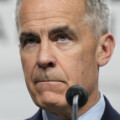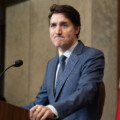U.S. President Trump’s executive order imposing a 25 percent tariff on all non-energy imports from Canada and a 10 percent tariff on energy imports is now effective. Separately, a 25 percent tariff was levied on all imports from Mexico and an additional 10 percent tariff was put on all imports from China. These rates are in addition to any tariffs or duties already charged.
The president invoked the International Emergency Economic Powers Act (IEEPA) to apply these tariffs. After declaring a national emergency at the southern border due to “the influx of illegal aliens and illicit drugs,” the president expanded this to cover “the public health crisis of deaths due to the use of fentanyl and other illicit drugs.” And, specifically, “the failure of Canada to do more to arrest, seize, detain, or otherwise intercept DTOs [drug trafficking organizations], other drug and human traffickers, criminals at large, and drugs.” However, in yesterday’s announcement that tariffs were indeed proceeding, the president suggested that auto plants and others should relocate production to the U.S. to avoid tariffs, revealing the true rationale behind the measures.
The original executive order also said: “Should Canada retaliate… the President may increase or expand in scope the duties imposed under this order.” Canada has announced 25 percent retaliatory tariffs on $155 billion CAD worth of imports from the U.S.: $30 billion effective March 4 and the remaining $125 billion after 21 days. Several provinces have also announced or are planning non-tariff measures.
It’s uncertain whether: 1) the U.S. will retaliate for Canada’s retaliation; 2) the administration will heed the calls from U.S. businesses for exemptions; and 3) if the executive order will survive legal challenges. However, by April 1, there will be three reports delivered to the president (under the America First Trade Policy memorandum) that should be full of tariff recommendations backed by investigations (or soon-to-be), setting the stage for more Section 201 (safeguard), Section 232 (national security), and Section 301 (unfair trade practices) tariffs. In consequence, tariffs on Canada and other countries could be around for a while—and could go potentially higher. In fact, “reciprocal” tariffs or industry-specific tariffs may be “stackable” on top of the initial 25 percent levy.
Given this backdrop, we are adjusting our forecasts, as outlined below. This is clearly a fluid situation, and further adjustments may be required in the weeks ahead, as more information comes to light in terms of Canada’s fiscal response, as well as any potential U.S. countermeasures, or even a possible off-ramp for the tariffs. For now, we are incorporating the information on hand, and assuming that the tariffs will be in place for a year. The main differences from our initial take a month ago are: a) the Canadian economy’s starting point was stronger than expected, including solid GDP growth around the turn of the year and sturdy job growth at the start of 2025, and b) the U.S. economy was softer than expected in early 2025, as sentiment was clearly souring through February.

President-elect Donald Trump speaks during an America First Policy Institute gala at his Mar-a-Lago estate, Nov. 14, 2024, in Palm Beach, Fla. Alex Brandon/AP Photo.
Economic impact on Canada
Trump’s tariff hammer will come down hard on Canada’s economy. If the announced tariffs remain in place for one year, the economy would face the risk of a moderate recession. A couple quarters of contraction are well within the realm of possibility. With little confidence given the lack of historical precedent, we estimate that the tariffs will reduce real GDP growth by roughly 1.5 ppts to around 0.5 percent in 2025. This reflects reduced demand for Canadian exports to the U.S. (which account for about a fifth of GDP), disrupted supply chains impeding business activity and consumption, and heightened uncertainty that reduces business investment.
It also reflects a reduction in domestic demand due to higher prices stemming from retaliatory tariffs and a weaker Canadian dollar. The estimated growth hit is a bit lighter than the Bank of Canada’s recent scenario (it called for about a 2.5 ppts reduction in GDP growth for the first year), due to the lesser 10 percent tariff on energy products, as well as the fact that Canada’s retaliation is measured. However, we recognize the difficulty in modelling such an extreme event, and certain sectors may not behave in a predictable or linear pattern—e.g., the highly integrated auto industry.
CPI inflation is expected to rise less than one ppt this year from the current 1.9 percent rate in January. But given growing slack in the economy and a likely more-than-one ppt increase in the unemployment rate to around 8 percent, inflation pressures should remain subdued, allowing for some moderation in 2026. Partly limiting the economic pain will be a weaker currency, lower interest rates, and an expected government relief program for jobless workers and affected businesses. These supports, along with the assumed revoking of tariffs after one year, should lead to a modest recovery in 2026, with average growth still close to 0.5 percent next year.
From a sectoral lens, a wide range of Canadian industries derive at least half of their revenue from U.S. exports. Near the top of the list is motor vehicles, but others with high exposure include auto parts, clothing, wood products, chemicals, medicines, rubber, iron and steel, aluminum, machinery, computers, and electrical equipment. In agriculture, tobacco, greenhouses, sugar, and seafood stand out. While the oil industry has very high exposure, we assume the 10 percent tariff will have little dampening effect given a combination of a weaker loonie, Canadian producer price cuts, and U.S. refinery cost absorption. The housing market recovery in Canada, as gradual as we expected it to be in the absence of tariffs, could be dampened this year by the confidence-sapping trade war, before resuming in 2026 on lower mortgage rates.
The president could increase tariffs further in response to retaliatory actions or on specific industries (steel, aluminum, copper, lumber, and autos), which would raise the risk of a deeper economic downturn. The potential long-term damage to Canada’s economy cannot be dismissed, either. Many businesses will increase production on the other side of the border to avoid tariffs. The uncertainty alone about further protectionism could put a chill on business investment for years, which is why the government’s response should also be directed at encouraging productivity-enhancing investment. This was already a necessity before tariffs given the new U.S. administration’s planned pro-business policies, including corporate tax cuts and lighter regulations.
Impact on the provinces
Direct exposure to U.S. trade varies across the country, and so will the impact. B.C. carries a relatively low share of goods exports in its economy, and roughly half of those are destined for markets outside the U.S., but some industries (e.g., forestry) will come under duress. Alberta, Saskatchewan, and Newfoundland, because of hefty energy exports, carry the largest exposure (exports to the U.S. are 20 percent to 35 percent of GDP); but, the lighter 10 percent tariff on such products, and the assumption that a portion will be passed to the U.S. consumer, leaves the impact to run smaller in these provinces—at least in the short run.
Non-energy U.S. export exposure is highest throughout Central Canada. In Ontario, for example, U.S. goods exports top 17 percent of GDP with a wide range of industries exposed (e.g., autos, machinery, metals, and consumer goods). Quebec’s industrial metals and manufactured goods will be vulnerable, as will Manitoba’s diverse manufacturing base. Atlantic Canada is susceptible because of a few highly-concentrated industries, even if the broad economic impact appears smaller—think the Newfoundland & Labrador fishery, and PEI packaged food goods.
All told, we expect the economic impact to hit hardest in Ontario and the rest of Central Canada; significantly impacting some concentrated industries in Atlantic Canada and B.C., while dealing a lesser immediate blow in oil-producing provinces.
A version of this article originally appeared at BMO Economics.









